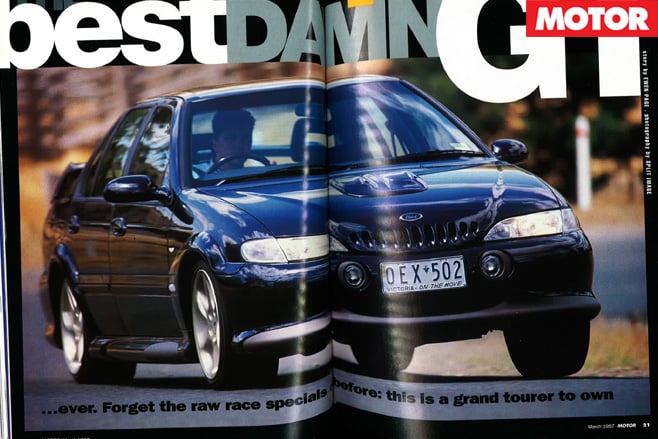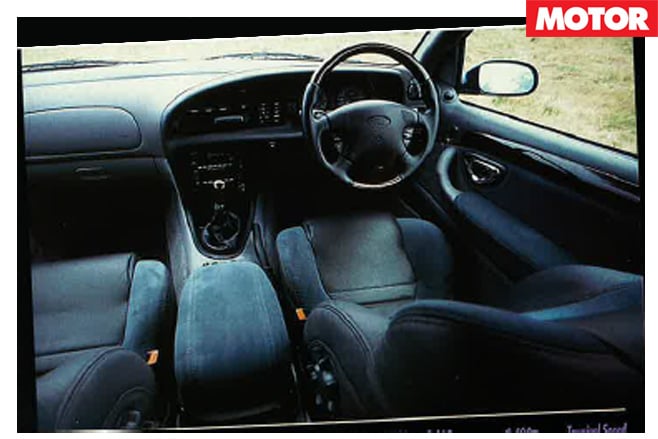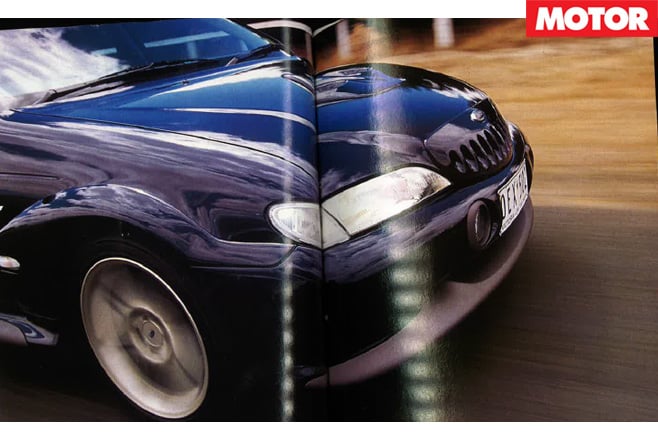Let’s cut straight to the chase: the 30th Anniversary Falcon GT is the best handling and road holding Falcon ever built, easily the most convincing GT to wear a Ford badge and, arguably, the finest live axle car in the world today.
This article was originally published in the March 1997 issue of MOTOR.
We don’t offer that endorsement lightly. But 1000 often hard-driven kays across back roads, main roads, freeways and urban streets convinced us Tickford Vehicle Engineering and Ford have successfully developed a major league Grand Tourer.
More powerful, more refined and, ultimately, more of a true V8 touring car than the last (EB) GT, this 1997 incarnation takes the big, fast, sports-luxury Australian car to its next, logical step. Its exterior styling may take some getting used to, but the GT’s balance and all-round performance package creeps beyond the envelope Ford, and lately Tickford, drew for themselves. Ford Australia has spent its $2 million wisely.
The EB GT broke-in diehards to the fact Ford was no longer into bare-boned muscle cars. For the 30th anniversary of the 1967 XR GT, Ford has refined the EB philosophy, rather than mimic a late-’60s mood. Ford and Tickford want you to know this. Both went to great lengths at the launch of the EB GT to cast in stone the message that GT meant GT, and GT-HO meant much more than Handling Option.

This time, Tickford’s chassis and engine tune are more closely matched. No-one’s saying, but you’re left with the very strong impression that criticism of the EB GT’s straight-line performance weighed on the production planners’ minds.
Why, Howard Marsden’s development team even investigated returning to the magic 351 cubic-inch capacity to kick owners in the pants and recalcitrant motoring journos in the teeth. They couldn’t, because a packaged 351 block doesn’t fit in the Falcon’s engine bay. And the 5.0-litre Windsor engine won’t accept a crank of long enough stroke to make the magic 35lci mark.
Engines are basically big air pumps, so it’s no great surprise that Tickford’s engine team, led by former Bosch boffin Rolf Glenk, concentrated on improving airflow from intake to exhaust. The aim here was to improve intake speed, to better feed the free-flowing GT40 heads (as used on Mustang GT in the US), cram as much intake charge as possible into the cylinder, before giving it an even bigger, 9.0: l squeeze and banging the gasses out through a four-into-one dual system. The result is 200kW at 4700rpm and 420Nm at 3700rpm, but how does it drive?

The standard V8 gets to a point where it simply can’t gulp down enough air to keep the rate of increase in engine speed happening. The GT keeps going and going and it’s only once you have close to six grand on the tacho the thing starts to show any sign of oxygen deprivation.
This is a responsive, well behaved, high performance engine. With 300Nm available at 1000rpm, you’re in good shape to get that 1674kg mass moving quickly from rest. And it does. At Calder the GT turned a near 15sec-neat 400 metre time and raced to the 100km/h mark in 7.03sec. That’s 0.62sec quicker than we managed with the EB GT and almost identical to Ford’s claims.
Getting those numbers requires a very delicate dialling-in of wheelspin: a fraction too much and you’re slow; too little and the engine comes off its mid-range… and you’re slow again. With more time and practice, there’s a 14.9 in this car, no risk.
But like the EB GT, the chassis remains the car’s most impressive feature – and also the single most expensive area to develop.

The GT benefits from Hoinville knowing relatively early in the programme which tyre would be fitted to the car. The Yokohama A510’s ultimate grip is quite stunning, but the consistency of its stickiness impresses equally.
Part of this comes from the fact that under cornering loads, the outside tread blocks are forced together, presenting the road with a section of quasi-slick tyre. The A510 also features double wrapped steel and nylon belts, giving tremendous strength on the ‘road face’, which allowed the introduction of relatively straight sidewalls.
Because feathering of the tyre’s edge was now less likely, Hoinville was able to run with less negative C’Jmber (down to half a degree only), and wind on four degrees of castor, giving progressive loading of the steering with cornering forces.
The use of urethane bushings in the upper and lower front arms and the tie bars (in combination with painstakingly developed shock and damper rates) bring a sweet consistency to the GT’s responses. The blind obedience gives the driver confidence to press-on.

Tramlining is vastly reduced and there’s a sense of security about the front end that has you consistently .underestimating just how much cornering power is on offer. Very, very few owners will get their GT to the point of understeer, in the dry at least.
The rear end benefits from a fatter (24mm) anti-roll bar, stiffer springs and urethane bushings. Hoinville and Co. have done a great job of controlling that whacking great live axle, but impressive as the GT’s behaviour is – and on smooth roads, that’s absolutely vice-free – even the smartest engineers can’t overcome completely the problems associated with a big heavy axle and diff banging up and down in the back end.
Push hard – really hard – on our normal, broken and bumpy bitumen, and the GT will hop and twitch in the back end. Now there’s never been an Australian performance car that didn’t get lively in the tail when the going got tough, and the GT’s arguably the best behaved of any we’ve driven, but it would be untrue to say it was blemish-free. Not unsettling or outputting, but present all the same.
That aside, this GT is one of very few Australian performance cars that allow the driver to easily balance both the front and rear ends. Most big-engined, rear drivers tend to work the fronts pretty hard, but the GT will get on the outside back tyre on more open corners and does respond to throttle position.

Needless to say, anyone accustomed to manual V8s will find the clutch effort no effort at all. Combined with a shortish first gear it asks for no great expertise when trying to get away quietly. If evidence was needed of the Australian component industry’s competitiveness, the GT’s BTR five- speed is it. In the EB, Tickford sourced special gear sets from the US to cope with the car’s torque loadings. This time, the standard-in-XR8 box and dice was just fine, thanks to improvements in BTR’s methods and materials.
And then there’s the GT aesthetic. Thought we’d leave that to last, even though it’s probably the only element of the car even committed Fordisi might have trouble with. Ford’s chief penman Steve Park knew this when he sat down to give the car “the most aggressive feel we could”.
He understood not everyone would go for the left-field grille and barn-door rear wing, which reduces lift at the rear by 70 percent. Park’s view is that cars should pass the “50 metre test”; that is, to catch your eye from 50 metres away.

The interior exemplifies a mature, well executed design. Using leather and Escaine, its dark greys and blacks are classy, yet still functional, while the Momo part-woodrimmed wheel and shifter knob will appeal to the intended 40-somethings market.
Each front door trim carries a GT logo with build number. The re-cushioned and trimmed buckets are comfortably firm and multi-adjustable, but their position within the car remains standard. Personally, that’s a disappointment, because it has always seemed the hip-point (how far your hip is above the floor) is too high on bread and butter Falcons. It just feels out of place in a car with sporting qualities.
Tough criticisms? Not really. This is an impressive piece of work, and testament to the ingenuity and hard work to be found in the Australian car industry. People like the Tickford start with a base car developed on a (by world standards) tiny budget, throw in a tiny bit more and out pops a thoroughly engineered, credible and exciting grand tourer. A GT truly worth its name.
SPECS Body: Four door sedan Layout: Front engine, rear-wheel drive Engine: 4942cc V8, OHV, 16v Induction: electronic multi-point fuel injection Power: 200 kW at 4700rpm Torque: 420 Nm at 3700rpm Compression ratio: 9.0:1 Bore x stroke: 101.6mm x 76.2mm kerb weight: 1674kg Weight/Power: 8.37kg/kW Specific pwer: 40.8kW/litre Transmission: five-speed manual Ratios: 1st 2.95; 2nd 1.94; 3rd 1.34; 4th 1.00; 5th 0.73 Suspension: Independent by short arm/long spindle with coil springs; dampers and anti-roll bar(front); live axle located by Watts linkage with coil spring, dampers and anti-roll bar(rear) L/W/H: 4931/1888/1394 mm Wheelbase: 2791mm Steering: Power assisted rack and pinion Turning circle: 10.9m Turns lock-to-lock: 2.8 Brakes: 329mm(front), 299mm(rear), ABS Wheels: Aluminium, 17 x 8.5-inch Tyres: Yokohama A510 245/ 40 VR17 Fue/tank capacity: PULP/68 litres Fuel economy: 14.64 litres/100km Price: $69,500 (manual and auto)





